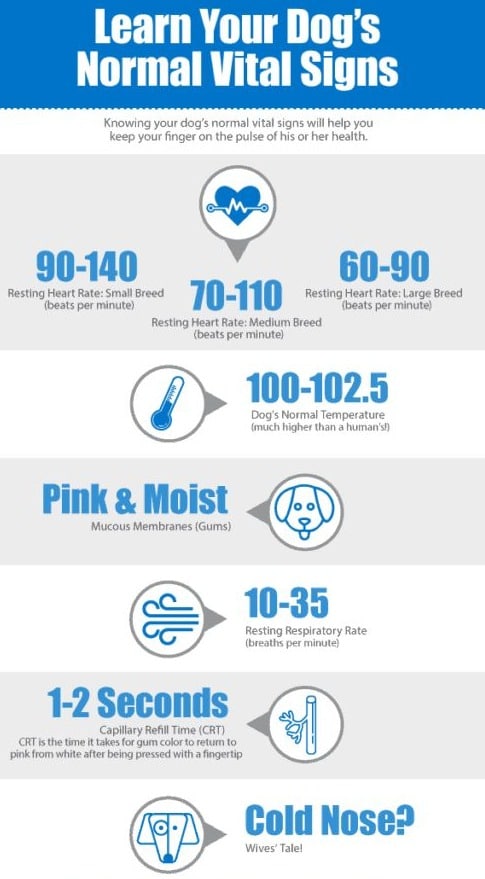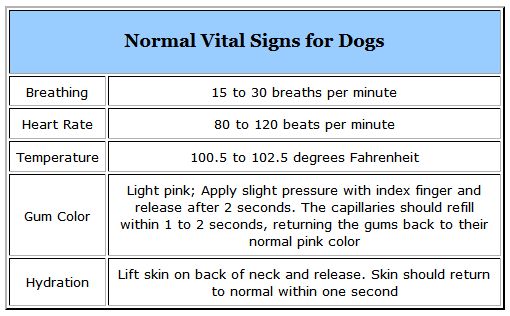Dog Heart Rate: Understanding Your Dog’s Vital Signs
The animal you love is not just a pet; it’s an essential part of your family. As a good dog owner, you should prioritize your dog’s health. In the same way, vital signs tell you a lot about your health; you need to know your dog’s vital signs to take care of them. Knowing your dog’s heart rate is one of these vital signs that can tell you a lot.
It tells you much about their general health and can help you monitor changes and spot problems early. We’ll learn about dog heart rate in detail in this article.
By learning about these essential parts of your dog’s health, you’ll be better prepared to ensure your beloved dog lives a long, happy, and healthy life.
Typical Vital Signs for a Dog

Some vital signs tell you about a dog’s health, just like they are for people. Keeping an eye on your dog’s vital signs can tell you a lot about their health and help you spot problems before they worsen. We’ll talk about dogs’ most common vital signs, such as their body temperatures, average dog heart rate, and breathing rate.
If you know these standard ranges, you can closely monitor your furry friend’s health and quality to spot any changes that might need your attention. Every dog owner needs to know what’s ‘normal’ when it comes to their dog. If you check your dog’s vital signs often and know what they mean, you can give your four-legged friend the best care and attention possible. The dog’s heart rate, breathing rate, and body temperature of a dog are all normal.
In this guide, we’ll get into more detail about these points.
How to Keep an Eye on Your Dog’s Health
To take care of your dog, you must know its vital signs. If you know what’s normal for your dog, you can quickly spot any changes that could be signs of a health problem. In an emergency or during regular checkups, seeing if a typical dog’s heart rate, breathing rate, and body temperature can be conducive is essential. To help you better understand these vital signs and what they mean for you, you need to look at them.
As a responsible pet owner, you must regularly monitor your dog’s vital signs and general health. Remember that every dog is different, and their vital signs may change depending on their breed, age, and how active they are.
By learning your dog’s regular vital signs, you’ll be better able to spot any changes from the norm and ensure your dog stays healthy and happy.
Vital Signs Chart: Important Signs for Dogs

This helpful tool gives you a quick visual comparison of your dog’s typical vital signs. A dog vital signs chart usually measures the typical dog’s heart rate, breathing rate, and body temperature.
It helps pet owners figure out if their furry friends are healthy or if there’s a problem. Pet owners can use these charts to help them check and monitor their dogs’ vital signs as part of routine care. By paying close attention to these critical signs, you can quickly spot any problems and take quick action to protect your dog’s health.
Additional Bonus: Busting Cold Nose Myth
Dog owners often think that a cold, wet nose means the dog is healthy and happy, while a warm or dry nose could mean something is wrong. This isn’t true; a dog’s nose temperature isn’t an excellent way to tell if they’re generally healthy. The temperature of a dog’s nose isn’t a good way to tell if they’re healthy generally. The temperature of a dog’s nose can change throughout the day depending on the weather, how active the dog is, and even the dog itself.
To get a good idea of your dog’s health, you need to use more solid tools, like the information in the dog’s vital signs chart. You can do better by checking the average dog’s heart rate, breathing rate, and body temperature. Sometimes, your dog’s warm, dry nose is normal and not a sign of sickness. Instead of relying on old wives’ tales, using detailed information in veterinary standards is always better.
Learn the Vital Signs of Your Dog
Your dog’s vital signs can tell you much about their health and well-being. By becoming familiar with their standard, you’ll be better able to spot any changes or deviations. The primary vital signs are a regular dog heart rate, body temperature, and breathing rate. It showcases the importance of mucous membrane color and teaches you to be better at caring for your health.
Check Normal Dog Heart Rate, Breath Rate, & Temperature

Keeping an eye on your dog’s vital signs can tell you a lot about their health. Here are the steps you need to take to check your dog’s temperature, breathing, and pulse. With these steps, you can keep a close eye on your furry friend and quickly spot any problems that might be happening.
1. Procedure to Check Normal Dog Heart Rate
Find your dog’s pulse. It’s usually in the femoral artery in the back leg. If you want to feel something moving, gently press your fingers on this area. The number of beats in 15 seconds equals four times that number, which is the beats per minute.
2. Procedure to Check Breathing
Look at your dog’s chest or sides to see if they are breathing. How many breaths do you take in 15 seconds? Multiply that number by four to get the number of breaths per minute (bpm).
3. Procedure to Take a Temperature
Use a digital rectal thermometer or a dog mate ear thermometer. After putting the thermometer tip in gently (about 1 to 1.5 inches into the rectum or as directed by the thermometer), please wait for it to beep (for digital thermometers). A dog’s body temperature should be between 100.5°F and 102.5°F (38°C and 39°C).
During these checks, remember to be gentle and make sure your dog is calm so that you can get accurate results. You should talk to your vet if you see significant changes from the standard ranges.
What is the Average Heart Rate of Dogs?

Finding out your dog’s heart rate is essential to monitoring their health. Dog’s normal heart rates depend on their age and size. These are some broad rules:
1. Puppy Heart Rate
A puppy’s heart beats faster than a grown dog’s. The average dog heart rate is usually between 120 and 160 beats per minute (bpm). The hearts of small breeds tend to beat faster.
2. Heart Rate of An Adult Dog
Most grown dogs’ heart rates are between 60 and 140 beats per minute, with most being between 80 and 120 beats per minute. The heart rates of more giant animals tend to be slower than those of smaller breeds.
3. Heart Rate of An Old Dog
Like people, dogs’ heart rates can decrease as they age. The heart rate of most older dogs is between 60 and 90 beats per minute. Remember that these are just suggestions; each person may react differently.
Follow the steps above to find out the average dog’s heart rate. You should talk to your vet if you are worried about your dog’s health or heart rate.
How Hot or Cold is a Dog’s Body Usually?
Knowing a dog’s average body temperature can tell if it is sick or in pain. Here are the main points :
1. Normal Body Temperature
A good dog’s body temperature is between 38.0° C and 39.2° C, or 100.5° F to 102.5° F. Because different breeds can have different needs, it’s essential to have a baseline number of your dog.
2. Checking Body’s Temperature
A digit rectal thermometer can be used to find out how hot or cold your dog is. After putting some oil on the tip, slowly insert it into your dog’s rectum. Then, wait for the reading to appear. Carefully do this so that you don’t hurt yourself.
3. Fever and Hypothermia
Temperatures above 102.5° F can mean you have a fever, while temperatures below 100.5°F can mean you are hyperthermic. Both problems need to be treated right away by a vet.
4. Exercise and Stress
Remember that a dog’s body temperature can rise when stressed or active. The best time to take their temperature is when they are calm and not moving.
If you know your dog’s average body temperature, you can immediately notice any changes and take your dog to the vet immediately.
How Fast Should a Dog’s Heartbeat Be?
Another vital sign to watch is the dog’s respiration rate or breathing rate. Here is what you need to know about how fast a dog normally breathes:

1. Normal Rate of Breathing
The average breathing rate for a healthy dog is between 10 and 30 breaths per minute. Most of the time, puppies breathe faster than grown dogs.
2. Keeping Track of Breaths
To find out how fast your dog breathes, watch how their chest moves or put a light hand on their side and feel their breaths. Please keep track of how many breaths they take in one minute.
3. High Respiratory Rate
If your breathing rate is much higher than normal, it could mean you are stressed, sick, or in pain. It could also be a sign of trouble if the rate is lower than usual.
4. Watch Out for Chest Pain
If you see heavy panting, wheezing, or short, quick breaths, this could mean that you are having trouble breathing. If you notice these signs, you should talk to your vet because they could be signs of deeper health problems.
It is very important to know your dog’s normal breathing rate. Keep an eye on their breathing when they are calm and at rest so you can quickly spot any problems and get medical help if needed.
Importance of Knowing What Color the Mucous Membrane Is
Looking at the color of a dog’s mucous membranes can tell you a lot about their health. It is why the color of the mucous tissues is important:
1. Indicator of Blood Circulation
Dogs’ gums and other mucous tissues, like the inside of their lips, should be pink, which means their blood flow is good. Pink nasal membranes on a healthy dog mean the blood flows well and the dog gets enough oxygen.
2. Pale Gums
Gums that are pale or white can be a sign of anemia or poor blood flow, which could be caused by shock, internal bleeding, or other major health problems.
3. Bright Red Gums
Gums that are bright red could be a sign of heatstroke, high blood pressure, or the beginning stages of shock.
4. Yellow or Jaundiced
Yellow mucous membranes can be a sign of problems with the liver or hemolysis, which is when red blood cells break down. Jaundice in dogs is a serious disease that needs to be treated right away by a vet.
5. Blue or Purple Gums
Bluish or purple mucous membranes may mean the body isn’t getting enough oxygen, which can be caused by breathing or heart issues.
6. Gum Capillary Refill Time
Veterinarians often check capillary refill time (CRT) along with color. To do this, press your finger against the gum to turn it white, then let go of it to see how fast the color returns. Long-term CRT could be a sign of trouble with the circulation.
7. Change in Color of the Mucous Membrane
If you notice a sudden change in the color of your dog’s mucous membrane or CRT, which lasts for a long time, you should talk to your doctor. These changes could be signs of deeper health problems.
8. Tests for Dehydration
Mucous membranes that feel dry or sticky can be a sign of dehydration. Ensuring your dog gets enough water is important for their health, so give them fresh water often.
If you know what color and state your dog’s mucous membranes are in, you can spot possible health problems early and take care of them. Taking your dog to the vet for regular checkups is also important for keeping his health healthy.
How Can You Tell if Your Dog is Drinking Enough?
Your dog needs to drink a lot of water to stay healthy. Find out how to tell if your pet is drinking enough water by learning about their skin’s flexibility and how long it takes for capillaries to refill. You can ensure your dog gets enough water by doing these easy tests.
1. Skin Elasticity
Lift a small piece of skin from the back or scruff of your dog’s neck. The skin will quickly snap back into place on a dog with enough water. It could signify thirst if it returns slowly or stays in its tent.
2. Moisture of The Gums
Feel your dog’s gums to see how moist they are. A dog’s gums should feel wet and slippery if it drinks enough water. Too little water can make a dog’s gums dry or sticky.
3. Check for Sunken Eyes
Eyes that are sunken or deeply set can be a sign of being dehydrated. Dogs that drink enough water have eyes that look bright and shiny.
4. Check Urine Color and frequency
A dog’s urine to see what color it is and how often it comes out. Lack of water can cause urine to be dark yellow or amber, a sign of concentrated pee. Watch how frequently your dog urinates; if they don’t do it very often, there may be a problem.
5. Lethargy and Weakness
Dogs needing more water may look tired, weak, or uninterested in doing normal things.
Conclusion
Finally, knowing your dog’s vital signs, like their heart rate, is important to being a caring pet owner. By learning these measures, you can keep a closer eye on your dog’s health and quickly spot any problems that may come up. If you know what is normal for your furry friend, you can give them the best care and make sure they are generally healthy.
Remember that these tips can help you determine how healthy your dog is, but you should always talk to your vet for professional help and advice. Taking your dog to the vet for regular checkups, especially as they get older, can help keep them healthy and solve any problems that might arise.
Don’t forget that your constant love, care, and attention will make your dog live a long and happy life.
Frequently Asked Questions
What Does a Normal Dog’s Heart Rate Look Like?
A normal dog’s heart rate can change based on age and size. But in general, the heart rate of a fit adult dog is between 60 and 140 beats per minute.
Does a Dog’s Racing Heart Rate Mean It’s Stressed?
Worry, anxiety, or excitement can increase a dog’s heart rate, just like in people. It’s usually nothing to worry about if your dog’s heart rate increases when stressed, but you should always talk to your vet if unsure.
How Can I Get a Rending of My Dog’s Heart Rate at Home?
Stand behind your dog’s front leg and touch their closet. Then, count how many times their heart beats in 15 seconds. To find their beats per minute (BPM), multiply that number by 4.






